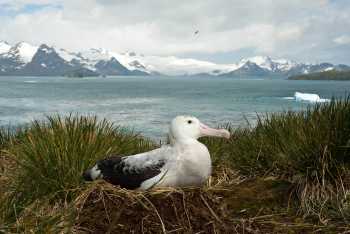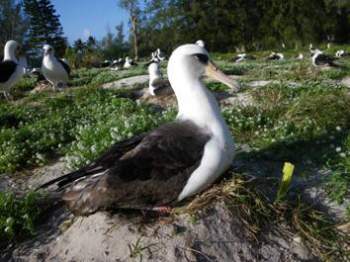Yvan Richard (Dragonfly Science, Wellington, New Zealand) and colleagues have published open access in the online journal PeerJ on aspects of the demographic rates of Northern Royal Albatrosses Diomedea sanfordi that breed on Taiaroa Head on New Zealand’s South Island.
The paper’s abstract follows:
“Demographic rates, such as annual survival rate, are generally difficult to estimate for long-lived seabirds, because of the length of time required for this kind of study and the remoteness of colonies. However, a small colony of northern royal albatross (Diomedea sanfordi) established itself on the mainland of New Zealand at Taiaroa Head, making possible regular banding and monitoring of its individuals since the first chick fledged, in 1938. Data on the presence/absence of birds, as well as on breeding outcomes, were available for the period from 1989–90 to 2011–12, and included 2128 annual resightings of 355 banded individuals of known age. The main goal of the present study was to estimate the annual survival rate of juveniles, pre-breeders, and adults at Taiaroa Head. These rates were estimated simultaneously in a single Bayesian multi-state capture-recapture model. Several models were fitted to the data, with different levels of complexity. From the most parsimonious model, the overall annual adult survival rate was estimated as 0.950 (95% CI [0.941–0.959]). In this model, adult survival declined with age, from 0.976 (95% CI [0.963–0.988]) at 6 years, the minimum age at first breeding, to 0.915 (95% CI [0.879–0.946]) at 40 years. Mean annual survival of pre-breeders was 0.966 (95% CI [0.950–0.980]), and 0.933 (95% CI [0.908–0.966]) for juveniles. There was no discernible difference in survival between males and females, and there was no apparent trend in survival over time. Estimates of other demographic rates were also obtained during the estimation process. The mean age at first return of juveniles to the colony was estimated as 4.8 years (95% CI [4.6–5.1]), and the mean age at first breeding as 8.9 years (95% CI [8.5–9.3]). Because all the birds of the colony were banded, it waas possible to estimate the total population size. The number of northern royal albatross present annually at the Taiaroa Head colony has doubled since 1989–90, and the current total population size was estimated to be over 200 individuals. The ratio of the total population size to the number of annual breeding pairs varied from5 to 12 among years, with an overall mean of 7.65 (95% CI [7.56–7.78]), and this high variability highlights the need for a sufficient number of surveys of seabird breeding populations before reliable conclusions on population trends can be made. Although long-term data allowed estimates of demographic rates of northern royal albatross at Taiaroa Head, the location of the colony and the ongoing management by staff mean that the population dynamics may differ from those of the main population on the Chatham Islands.”

Nothern Royal Albatross and chick at Taiaroa Head, photograph by Lydon Perriman
With thanks to Barry Baker for information.
Reference:
Richard, Y., Perriman, L., Lalas, C. & Abraham, E.R. 2015. Demographic rates of northern royal albatross at Taiaroa Head, New Zealand. PeerJ 3:e906. DOI 10.7717/peerj.906

 English
English  Français
Français  Español
Español 


